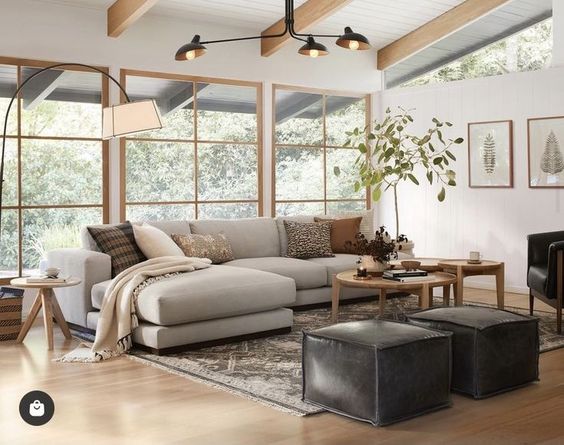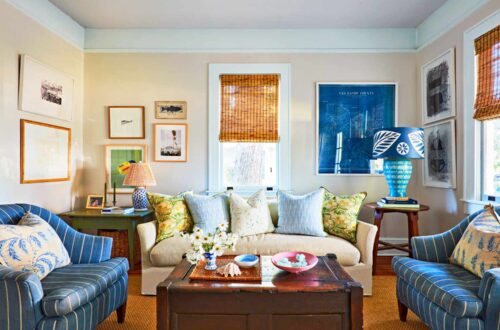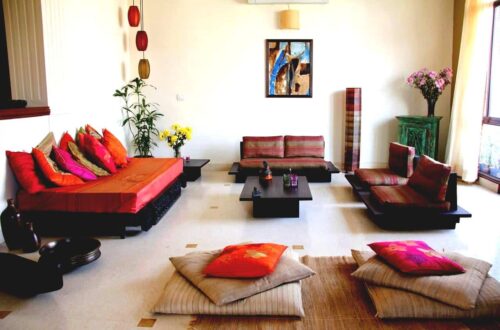Hey there, I’m Builder Boy, a guy who’s spent the last decade turning cluttered houses into serene sanctuaries. Back when I started flipping homes in my twenties, I was all about packing in every trendy piece I could find—think mismatched sofas and walls crammed with posters. But after one particularly chaotic renovation where I tripped over a pile of unnecessary knick-knacks, I had my “aha” moment. Minimalism isn’t just a style; it’s a mindset that cleared my space and my head. In this guide, we’ll dive deep into minimalist home decor ideas that keep things simple, functional, and downright peaceful. Whether you’re in a tiny apartment or a sprawling family home, these tips will help you strip away the excess and focus on what truly matters. We’ll cover everything from color choices to room-specific setups, with a nod to current trends like warm neutrals and sustainable materials. Trust me, once you go minimal, you’ll wonder why you ever tolerated the clutter. Let’s get started on creating a home that feels like a breath of fresh air.
What is Minimalist Home Decor?
Minimalist home decor strips design down to its essentials, prioritizing clean lines, open spaces, and purposeful items over excess. It’s about creating harmony through simplicity, where every piece serves a function or brings genuine joy, avoiding visual overload. Drawing from influences like Japanese Zen and Scandinavian hygge, this style fosters calm in our busy lives—imagine walking into a room that instantly soothes your soul rather than bombarding it.
Key Principles of Minimalism in Design
At its core, minimalism revolves around decluttering, quality over quantity, and neutral palettes that let architecture shine. Think multifunctional furniture like a sleek coffee table that doubles as storage, or walls left bare to highlight natural light streaming in. It’s not cold or empty; it’s intentional, making your home feel expansive and inviting without the weight of unnecessary stuff.
- Declutter Ruthlessly: Start by removing items that don’t spark joy or utility—donate, sell, or recycle to free up space.
- Focus on Functionality: Choose pieces that multitask, like ottomans with hidden compartments.
- Embrace Negative Space: Leave areas empty to create breathing room and emphasize key elements.
- Natural Materials: Opt for wood, stone, or linen for an organic touch that ages gracefully.
Benefits of Minimalist Decor
Switching to minimalist decor transformed my own home from a stressful mess to a relaxing retreat—I remember the first time I hosted friends and they commented on how “zen” it felt. It reduces visual noise, making cleaning easier and promoting mental clarity in a world full of distractions. Plus, it’s budget-friendly long-term since you invest in durable, timeless pieces rather than fleeting trends.
Pros and Cons of Adopting Minimalism
Pros include lower maintenance, enhanced focus, and eco-friendliness through less consumption. On the flip side, it might feel too sparse at first or require discipline to avoid impulse buys.
Pros:
- Easier to clean and organize.
- Promotes mindfulness and reduces stress.
- Saves money by buying fewer, better items.
- Versatile for small or large spaces.
Cons:
- Can seem impersonal without personal touches.
- Initial decluttering is time-consuming.
- Might not suit families with kids’ toys everywhere.
- Requires ongoing commitment to simplicity.
Minimalist Color Palettes
Colors in minimalist decor act as a subtle backdrop, with soft neutrals like beige and gray creating a canvas for life to unfold. I once painted my entire living room in warm white, and it made the space feel twice as big—perfect for that cozy yet airy vibe. Stick to a limited scheme to maintain cohesion, layering tones for depth without overwhelming the eye.
Popular Neutral Tones for 2025
Warm minimalism is trending, shifting from stark whites to earthy hues that add subtle coziness. Think plaster walls in soft taupe or light oak floors that ground the room naturally.
| Color | Hex Code | Best Room | Why It Works |
|---|---|---|---|
| Warm White | #F5F5F5 | Living Room | Brightens spaces, versatile base. |
| Soft Gray | #D3D3D3 | Bedroom | Calming, pairs with wood accents. |
| Beige | #F5F5DC | Kitchen | Adds warmth, hides minor dirt. |
| Light Taupe | #B38B6D | Bathroom | Earthy, spa-like serenity. |
Furniture Choices for Minimalist Homes
Furniture in minimalist design should be sleek and multifunctional, like a low-profile sofa that anchors the room without dominating it. In my workshop days, I built a simple bench that served as seating, storage, and a side table—proof that less can do more. Prioritize clean lines and natural finishes to keep the flow uninterrupted.
Comparing Minimalist vs. Traditional Furniture
Minimalist pieces emphasize form and function, while traditional ones often feature ornate details and heavier builds. For example, a minimalist coffee table might be a slim slab of wood on metal legs, versus a carved mahogany one in traditional style.
Comparison Table:
| Aspect | Minimalist | Traditional |
|---|---|---|
| Design | Clean, geometric | Ornate, curved |
| Materials | Wood, metal, glass | Mahogany, velvet |
| Functionality | Multifunctional | Decorative focus |
| Space Impact | Opens up room | Fills visually |
| Cost | Often mid-range | Can be pricey |
Room-by-Room Minimalist Ideas
Breaking it down by room makes minimalism approachable—start small, like your bedroom, and expand. I’ve helped clients revamp entire homes this way, turning chaotic spaces into peaceful havens one area at a time. Focus on essentials that enhance daily life without adding clutter.
Living Room Minimalist Decor
Your living room should invite relaxation with a neutral sofa, a few statement pieces, and plenty of open floor space. I recall redesigning a friend’s cramped den by removing half the furniture; suddenly, it felt like a high-end lounge. Layer textures like a jute rug for warmth underfoot.
- Opt for a modular sectional that adapts to needs.
- Add a single abstract art piece as a focal point.
- Use built-in shelves for subtle storage.
- Incorporate plants for a touch of life without excess.
Pros and Cons of Minimalist Living Rooms:
Pros: Feels spacious, easy to rearrange. Cons: Might lack coziness if not textured well.
Bedroom Sanctuary Ideas
Bedrooms thrive on minimalism with low beds, crisp linens, and blackout curtains for restful sleep. When I minimized my own bedroom, ditching the bulky dresser for wall hooks, I slept better instantly—less stuff means less mental clutter. Keep nightstands simple with just a lamp and book.
- Choose a platform bed for a grounded look.
- Use under-bed storage for hidden essentials.
- Limit to one or two pillows for easy making.
- Hang mirrors to amplify light and space.
Kitchen Minimalism Tips
Kitchens benefit from open shelving and hidden appliances, keeping counters clear for cooking joy. I built custom cabinets in one project that concealed everything, making meal prep feel effortless and fun. Focus on durable materials like quartz that wipe clean easily.
- Install pull-out drawers for organized utensils.
- Display only everyday dishes on open shelves.
- Choose matte black hardware for a modern edge.
- Add a small herb garden for functional greenery.
Bathroom Bliss
Bathrooms shine minimalist with floating vanities and glass showers that maximize perceived space. Swapping my old pedestal sink for a wall-mounted one opened up the floor, making mornings less rushed. Use neutral tiles and simple fixtures for a spa-like escape.
- Opt for frameless mirrors to reflect light.
- Store toiletries in recessed niches.
- Choose rainfall showerheads for luxury minimalism.
- Add a single vase with fresh eucalyptus.
DIY Minimalist Decor Projects
DIY projects add personal flair without breaking the bank—like the floating shelves I crafted from reclaimed wood for my office. They hold books upright while keeping the desk clear, blending utility with style. Start with easy ones to build confidence in your minimalist journey.
- Wall Art from Scraps: Frame pressed leaves or simple line drawings for custom decor.
- Upcycled Planters: Turn old jars into succulent holders for green accents.
- Minimalist Headboard: Use plywood painted neutral for a quick bedroom upgrade.
- Cable Organizers: Hide cords with velcro ties to maintain clean lines.
Where to Find Minimalist Decor
Sourcing minimalist pieces is easier than ever, from online giants to local thrift stores. I’ve scored amazing finds at flea markets, like a vintage lamp that fits perfectly in modern setups. For quality, check sites like IKEA for affordable basics or West Elm for premium neutrals.
External links: Explore more ideas on The Spruce or Vogue’s minimal decor guide. Internal: See our /minimalist-furniture page for tips.
Best Minimalist Home Decor Products
For transactional picks, focus on versatile items that last. Based on trends, warm woods and subtle textures top the list for 2025. I recommend starting with a statement lamp—it’s transformative without overwhelming.
- Coucrek Floor Lamp: Modern standing lamp with three color temperatures, ideal for reading nooks. Available on Amazon.
- Ambimall Floor Lamp: Tall pole with lampshade for bedrooms, minimalist black finish.
- IBF Industrial Coffee Table: Rustic wood and metal, perfect for living rooms.
- AUQUEE Industrial Floor Lamp: Vintage farmhouse style with foot switch for ease.
People Also Ask
Drawing from common searches, here are real questions folks ask about minimalist decor, answered concisely.
What is a Minimalist Decorating Style?
It’s a design approach emphasizing simplicity, functionality, and neutral tones to create calm spaces. Avoid clutter by selecting only essential items that enhance daily living. Popular in 2025 for its warm twists on classics.
How Do I Make My House Look Minimalist?
Begin by decluttering room by room, then invest in multifunctional furniture and neutral paints. Add subtle textures like jute rugs for coziness without excess. It’s about editing down to what you love.
What Are Some Minimalist Colors?
Stick to whites, grays, beiges, and earth tones for serenity. In 2025, warmer shades like light oak and plaster are rising for inviting vibes.
Is Minimalism Good for Home?
Absolutely—it reduces stress, eases cleaning, and promotes sustainability. Though it may feel stark initially, personal touches make it homey and adaptable.
FAQ
How Can I Start Minimalist Decor on a Budget?
Focus on decluttering first—it’s free! Then thrift for neutral basics or DIY simple pieces like painted shelves. Invest gradually in quality items that last.
What Materials Work Best for Minimalist Homes?
Natural ones like wood, stone, and linen add warmth without clutter. Reclaimed options are eco-friendly and trending for 2025.
Can Minimalism Work in Small Spaces?
Yes, it’s ideal—open layouts and multifunctional furniture maximize every inch. My tiny first apartment felt huge after going minimal.
How to Add Personality to Minimalist Decor?
Incorporate a few meaningful items, like family photos or a favorite sculpture. Layer textures subtly to keep it personal yet uncluttered.
What’s the Difference Between Minimalist and Modern Decor?
Minimalist focuses on simplicity and function, while modern includes bold shapes and tech. They overlap but minimalism prioritizes less.
Wrapping up, minimalist home decor isn’t about deprivation—it’s liberation. As Builder Boy, I’ve seen it change lives, including mine, by creating spaces that nurture rather than distract. Give it a try; you might find, like I did, that simplicity brings the richest joy. If you’re ready to declutter and redesign, start small and watch your home transform. Thanks for reading—here’s to calmer, happier homes!





